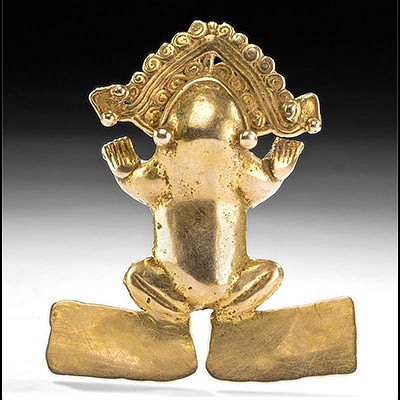11th C. Cambodian Khmer Stone Sculpture of Young Man
Lot 58
About Seller
Artemis Gallery
686 S Taylor Ave, Ste 106
Louisville, CO 80027
United States
Selling antiquities, ancient and ethnographic art online since 1993, Artemis Gallery specializes in Classical Antiquities (Egyptian, Greek, Roman, Near Eastern), Asian, Pre-Columbian, African / Tribal / Oceanographic art. Our extensive inventory includes pottery, stone, metal, wood, glass and textil...Read more
Estimate:
$3,000 - $5,000
Absentee vs Live bid
Two ways to bid:
- Leave a max absentee bid and the platform will bid on your behalf up to your maximum bid during the live auction.
- Bid live during the auction and your bids will be submitted real-time to the auctioneer.
Bid Increments
| Price | Bid Increment |
|---|---|
| $0 | $25 |
| $300 | $50 |
| $1,000 | $100 |
| $2,000 | $250 |
| $5,000 | $500 |
| $10,000 | $1,000 |
| $20,000 | $2,500 |
| $50,000 | $5,000 |
| $100,000 | $10,000 |
| $200,000 | $20,000 |
About Auction
By Artemis Gallery
Aug 13, 2020
Set Reminder
2020-08-13 10:00:00
2020-08-13 10:00:00
America/New_York
Bidsquare
Bidsquare : Fine Antiquities, Ethnographic & Fine Art
https://www.bidsquare.com/auctions/artemis-gallery/fine-antiquities-ethnographic-fine-art-5415
Features classical antiquities, ancient and ethnographic art from cultures encompassing the globe. Egyptian, Greek, Roman, Etruscan, Near Eastern, Asian, Pre-Columbian, Native American, African / Tribal, Oceanic, Spanish Colonial, Russian, Fine Art, so much more! Artemis Gallery info@artemisgallery.com
Features classical antiquities, ancient and ethnographic art from cultures encompassing the globe. Egyptian, Greek, Roman, Etruscan, Near Eastern, Asian, Pre-Columbian, Native American, African / Tribal, Oceanic, Spanish Colonial, Russian, Fine Art, so much more! Artemis Gallery info@artemisgallery.com
- Lot Description
Southeast Asia, Khmer Empire, Angkor Wat style, ca. 11th to 12th century CE. A sensual stone carving of a young man with an athletic torso. He is carved standing in the samabhanga position, wearing a short sampot with a double-anchor fold at the front and a pouch fanning across his left thigh. He also wears a belt with a double-oval pattern about the hips, and his torso is bare, with defined pectorals and a slightly rounded belly. He may have once had a cape based on some of the details on the remaining upper arms. The surface of the statue is smoothly polished with sloping contours and elegant craftmanship. Size: 13.5" W x 24" H (34.3 cm x 61 cm); 28" H (71.1 cm) on included custom stand.
The details are remarkable on this figure, especially of his clothing. In the Khmer style, the figure is three-dimensional, suggesting that he was made to be viewed from all angles and perhaps placed in the center of a room. in contrast to pre-Khmer artwork. He has a rich appearance, undoubtedly based on what elite men at the Khmer court would have worn themselves. While this artwork was religious - priests supervised its execution - its realism is unmistakable and some scholars believe that gods and goddesses were portrayed with the features of individual members of the royal court. This sculpture and others like it would have both emphasized the power of the monarchy and given high ranking people joy - after all, who wouldn't want to see themselves portrayed by the finest artisans, compared to a god?
Provenance: private J.H. collection, Beaverton, Oregon, USA, acquired in October 2003; ex-Ken Shores collection, Portland, Oregon, USA
All items legal to buy/sell under U.S. Statute covering cultural patrimony Code 2600, CHAPTER 14, and are guaranteed to be as described or your money back.
A Certificate of Authenticity will accompany all winning bids.
We ship worldwide and handle all shipping in-house for your convenience.
#154733One arm is reattached. Losses to head, lower arms, and lower legs. Surface wear commensurate with age, including some nicks, chips (notably on one leg), and scratches. Great preservation of detail on what remains and great deposits.Condition
- Shipping Info
-
All shipping is handled in-house for your convenience. Your invoice from Artemis Gallery will include shipping calculation instructions. If in doubt, please inquire BEFORE bidding for estimated shipping costs for individual items.
-
- Buyer's Premium



 EUR
EUR CAD
CAD AUD
AUD GBP
GBP MXN
MXN HKD
HKD CNY
CNY MYR
MYR SEK
SEK SGD
SGD CHF
CHF THB
THB














